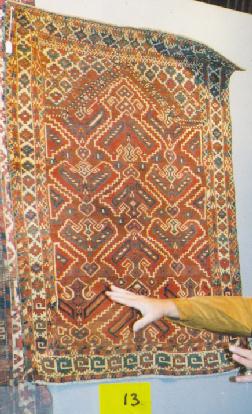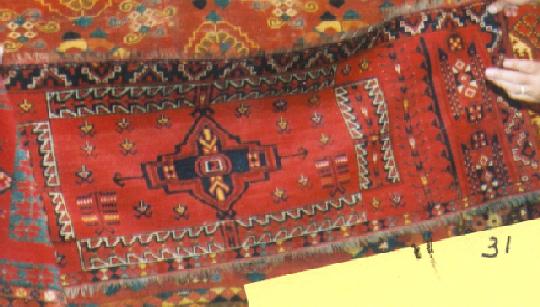Posted by Yon Bard on 02-24-2002 09:57 AM:
Ensi?
Its size and its asymmetry suggest to me that no. 13 is an ensi
rather than a small rug.
Also, pieces like no. 31 may be decorative trappings rather than bag faces.
Regards, Yon
P.S. wouldn't mind owning some of those pieces!
Posted by R. John Howe on 02-24-2002 01:42 PM:
Hi Yon -
I don't have the precise size of rug 13

but it could well be an ensi. The Yomuts, especially made some ensis that do not have the hatchli (cross; four
paneled) design. You can see in my comment that we noticed features that appear in some ensis. And rug 13 does
have a seeming arch feature that is often seen on ensis but that is also often omitted from those woven by Yomuts.
While we're talking about ensis, I'm thinking about them quite a bit these days because the planned Turkmen exhibition
at ICOC X is to be "ensis only." Peter Hoffmeister, the German collector is working with us on this exhibit
and I notice that he steadfastly writes "engsi" rather than "ensi." I haven't asked him but
does anyone remember what's involved in this difference in spelling? (Someone asked once why some many Turkmen
words are pronoounced differently by different Turkmen native speakers and ask why. A Turkman way responded that
it depended on how many teeth your grandmother had when she taught you to speak. :-) ) But maybe something more
serious going on with "ensi" and "engsi."
Yon, I also agree that rug 31 could be a trapping.

Seems wide for a functional bag, although I don't think anyone looked for signs of an original back.
And, yes, there's some material here that many of us would like to own.
Regards,
R. John Howe
Posted by Marvin Amstey on 02-24-2002 01:51 PM:
If it were an engsi, wouldn't it look like this:
Regards,
Marvin
Posted by Chuck Wagner on 02-24-2002 04:02 PM:
An engsi for who, the steppe leprechauns ?
It is the right size for a prayer rug.
Just a thought.
__________________
Chuck Wagner
Posted by R. John Howe on 02-24-2002 04:46 PM:
Chuck et al -
Most 19th century rugs that we see as ensis, are roughly 4 feet wide and 5 feet long. Some Salor ensis are 4 X
6 and the Ersaris seemed sometimes to make even larger ones.
But yes, many of them are of a size that might make one suspect that they could have been used as prayer rugs.
And since many also have arch designs at their tops, the old literature tended to call them prayer rugs. More recent
research has suggested that they were in fact door decorations and the notion that they might be prayer rugs has
now been frowned on in the literature for a few years.
But Eiland and Pinner in their Wiedersperg catalog note that often very old ensis have been found in very good
condition, suggesting that they were not routinely hung on doors for extended periods of time (felt seems to have
been the everyday material used for door rugs). They suggest that this likely means that ensis were part of the
weavings used primarily at weddings and which were then put away.
They then provide this sentence suggesting how circular the world of such interpretation can be. "...This,
of course, leaves room for those who like to speculate that the Tekke and Arabatchi ensis, with their single mirhab...may
have been used later on the floor as prayer rugs or on the wall as precious keepsakes or icons..." (p. 40).
This seems an unnecessary suggestion unless they seriously entertain this possibility.
Anyway, Chuck, there are some big time rug authors seeming to rehabilitate a bit the notion that at least some
ensis could at least sometimes have been used as prayer rugs.
Regards,
R. John Howe
Posted by Chuck Wagner on 02-24-2002 04:53 PM:
Some more thoughts, and more to the point..
(John, you got in while I was composing this. I guess I'll add: OK, so when is an ensi not an ensi. It doesn't
have any of the classic elements of an "ensi" that I'm aware of. But it's easy for me to believe that
a weaver might put "ensi" elements into a smaller utility rug just for aesthetic purposes. My pre-John
addendum follows..)
1) No elem panel
2) No internal major border defining the internal box, crossbeams or not
3) Asymmetry ? Well, certainly the main border switches motifs, but note also that (I don't think it's just the
photo) the whole internal panel changes tone and character. The lower part has well proportioned major and minor
elements, the internal element of the ram's horn shape is outlined in dark wool, and the inner curls of the rams
horn shape are well done.
Contrast that with the upper portion, where the rams horn shapes start expanding as the weaver starts running out
of loom and ideas, and where the execution looses a little something.
It seems that the rug may have been set aside for a while, and then continued. After Mom dished out a little tongue
lashing about how one doesn't cut off the edge of the horns (lower, pre-tongue lashing part) on Dad's new prayer
rug without getting into trouble.
__________________
Chuck Wagner
Posted by R. John Howe on 02-24-2002 05:33 PM:
Dear folks -
I don't want to be a "wet blanket" about this first thread on the ensi, but the truth is I am currently
already working on my next salon which will be entitled "What Can We Say About Engsis?"
So I'd like to ask that you all hold, for the moment, the very real energy you are exhibiting for this discussion.
We're going to have an entire month to explore what we know and don't with regard to this format.
Meanwhile, do your homework about whether that "g," that some folks seem to insist on, is important.
Thanks,
R. John Howe
Posted by Yon Bard on 02-24-2002 06:32 PM:
Chuck, by 'asymmetry' I was referring to the field.
The change of motif along the border is a clear example of an 'internal elem.'
John, what is the thing that's visible on the left of the piece?
Regards, Yon
Posted by Dennis Dodds on 02-24-2002 07:02 PM:
YOMUT PRAYER RUG #13
Yes, this piece is not an engsi, but a prayer rug. The arch
designates this as it symbolizes the mihrab in the mosque.
Engsis with quadripartite layouts get their erroneous "prayer" association from the old misconception
that the crossed vertical and horizontal axes formed a Christian cross and old Armenian dealers applied the term
"hachli" more as a design type than a function attribution.
Function is more impt than design when it comes to pieces used for the ritual of namaz -- prayer. Anything in any
design can be used to pray upon. I've observed prayer on non-gabled rugs, non-gabled kilims, newspapers, plain
cloth, even their own jacket to provide a "prayer place." For prayer, the Koran says only that "...you
shall prepare a CLEAN (emphasis mine) place."
I only know of fewer than a dozen "gabled" design prayer rugs among Trurkmen weavings and most of these
are of Tekke and Ersari/Beshir groups. This is the only gabled, Yomut family piece I've seen. I've not seen any
rugs with a gabled prayer arch that display the "Eagle motif" (after Pinner). It's palette is wide and
it has a lot of true undyed camel hair in the pattern.
It is about 3'8" X 4' and another image is in ORIENTAL RUGS FROM ATLANTIC COLLECTIONS, p.176, plate 198.
__________________
Dennis Dodds/MAQAM
All times are GMT -5 hours. The time now is 01:03 PM.
Powered by: vBulletin Version 2.2.1
Copyright © Jelsoft Enterprises Limited 2000, 2001.

